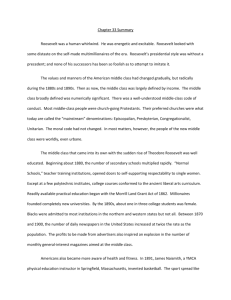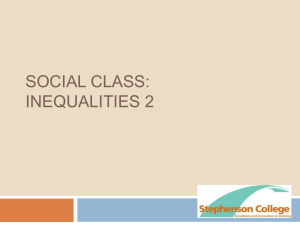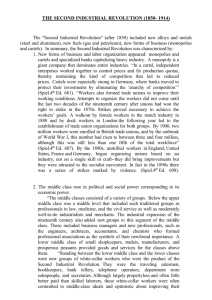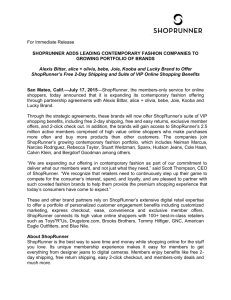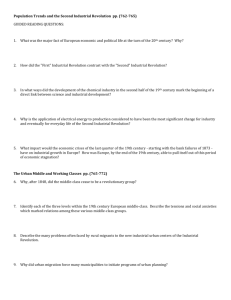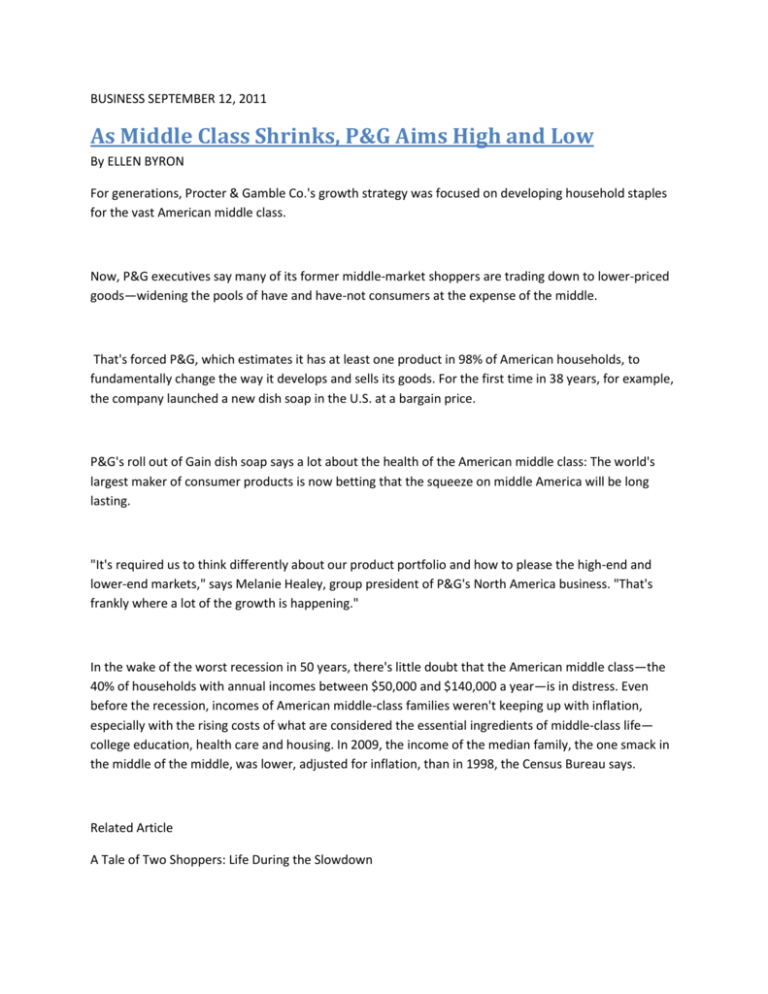
BUSINESS SEPTEMBER 12, 2011
As Middle Class Shrinks, P&G Aims High and Low
By ELLEN BYRON
For generations, Procter & Gamble Co.'s growth strategy was focused on developing household staples
for the vast American middle class.
Now, P&G executives say many of its former middle-market shoppers are trading down to lower-priced
goods—widening the pools of have and have-not consumers at the expense of the middle.
That's forced P&G, which estimates it has at least one product in 98% of American households, to
fundamentally change the way it develops and sells its goods. For the first time in 38 years, for example,
the company launched a new dish soap in the U.S. at a bargain price.
P&G's roll out of Gain dish soap says a lot about the health of the American middle class: The world's
largest maker of consumer products is now betting that the squeeze on middle America will be long
lasting.
"It's required us to think differently about our product portfolio and how to please the high-end and
lower-end markets," says Melanie Healey, group president of P&G's North America business. "That's
frankly where a lot of the growth is happening."
In the wake of the worst recession in 50 years, there's little doubt that the American middle class—the
40% of households with annual incomes between $50,000 and $140,000 a year—is in distress. Even
before the recession, incomes of American middle-class families weren't keeping up with inflation,
especially with the rising costs of what are considered the essential ingredients of middle-class life—
college education, health care and housing. In 2009, the income of the median family, the one smack in
the middle of the middle, was lower, adjusted for inflation, than in 1998, the Census Bureau says.
Related Article
A Tale of Two Shoppers: Life During the Slowdown
The slumping stock market and collapse in housing prices have also hit middle-class Americans. At the
end of March, Americans had $6.1 trillion in equity in their houses—the value of the house minus
mortgages—half the 2006 level, according to the Federal Reserve. Economist Edward Wolff of New York
University estimates that the net worth—household assets minus debts—of the middle fifth of
American households grew by 2.4% a year between 2001 and 2007 and plunged by 26.2% in the
following two years.
P&G isn't the only company adjusting its business. A wide swath of American companies is convinced
that the consumer market is bifurcating into high and low ends and eroding in the middle. They have
begun to alter the way they research, develop and market their products.
Food giant H.J. Heinz Co., for example, is developing more products at lower price ranges. Luxury retailer
Saks Inc. is bolstering its high-end apparel and accessories because its wealthiest customers—not those
drawn to entry-level items—are driving the chain's growth.
CloseCitigroup calls the phenomenon the "Consumer Hourglass Theory" and since 2009 has urged
investors to focus on companies best positioned to cater to the highest-income and lowest-income
consumers. It created an index of 25 companies, including Estée Lauder Cos. and Saks at the top of the
hourglass and Family Dollar Stores Inc. and Kellogg Co. at the bottom. The index posted a 56.5% return
for investors from its inception on Dec. 10, 2009, through Sept. 1, 2011. Over the same period, the Dow
Jones Industrial Average returned 11%.
"Companies have thought that if you're in the middle, you're safe," says Citigroup analyst Deborah
Weinswig. "But that's not where the consumer is any more—the consumer hourglass is more
pronounced now than ever."
Companies like Tiffany & Co., Coach Inc. and Neiman Marcus Group Inc., which cater to the wealthy,
racked up outsize sales last Christmas and continue to post strong sales.
Tiffany says its lower-priced silver baubles, once a favorite of middle-class shoppers craving a small
token from the storied jeweler, are now its weakest sellers in the U.S. "I think that there's probably
more separation of affluence in the U.S.," Tiffany Chief Operating Officer James Fernandez said in June.
Firms catering to low-income consumers, such as Dollar General Corp., also are posting gains, boosted
by formerly middle-class families facing shrunken budgets. Dollar stores garnered steady sales increases
in recent years, easily outpacing mainstream counterparts like Target Corp. and Wal-Mart Stores Inc.,
which typically are more expensive.
P&G's profits boomed with the increasing affluence of middle-class households in the post-World War II
economy. As masses of housewives set up their new suburban homes, P&G marketers pledged that Tide
detergent delivered cleaner clothes, Mr. Clean made floors shinier and Crest toothpaste fought off more
cavities. In the decades since, new features like fragrances or ingredient and packaging enhancements
kept P&G's growth robust.
Despite its aggressive expansion around the world, P&G still needs to win over a healthy percentage of
the American population, because the U.S. market remains its biggest and most profitable. In the fiscal
year ended June 30, the U.S. delivered about 37% of P&G's $82.6 billion in annual sales and an
estimated 60% of its $11.8 billion in profit. P&G says that Americans per capita spend about $96 a year
on its products, compared with around $4 in China.
During the early stages of the recession, P&G executives defended its long-time approach of making
best-in-class products and charging a premium, expecting middle-class Americans to pay up.
But cash-strapped shoppers, P&G learned, aren't as willing to splurge on household staples with extra
features. Droves of consumers started switching to cheaper brands, slowing P&G's sales and profit gains
and denting its dominant market share positions.
In late 2008, unit sales gains of P&G's cheaper brands began outpacing its more expensive lines despite
receiving far less advertising. As the recession wore on, U.S. market-share gains for P&G's cheaper Luvs
diapers and Gain detergent increased faster than its premium-priced Pampers and Tide brands.
At the same time, lower-priced competitors nabbed market share from some of P&G's biggest brands.
P&G's dominant fabric-softener sheets business, including its Bounce brand, fell five percentage points
to 60.2% of the market as lower-priced options from Sun Products Corp. and private-label brands picked
up sales from the second quarter of 2008 through May 2011, according to a Deutsche Bank analysis of
data from market-research firm SymphonyIRI.
P&G's grasp of the liquid laundry detergent category, led by its iconic Tide brand, also posted a rare slip
over the same period as bargain-priced options from Sun and Church & Dwight Co. gained momentum.
Even the company's huge Gillette refill razor market suffered, declining to 80.1% by May from 82.3% in
the second-quarter of 2008, as Energizer Holdings Inc.'s less-expensive Schick brand gained nearly three
points.
P&G began changing course in May 2009. After issuing a sharply lower-than-expected earnings forecast
for the company's 2010 fiscal year, then-CEO A.G. Lafley said the company would take a "surgical"
approach to cutting prices on some products and develop more lower-priced goods. "You have to see
reality as it is," Mr. Lafley said.
When the company's 2009 fiscal year ended a month later, P&G's sales had posted a rare drop, falling
3% to $76.7 billion.
In August that year, P&G's newly appointed CEO, company veteran Robert McDonald, accelerated the
new approach of developing products for high- and low-income consumers.
"We're going to do this both by tiering our portfolio up in terms of value as well as tiering our portfolio
down," Mr. McDonald said in September 2009.
To monitor the evolving American consumer market, P&G executives study the Gini index, a widely
accepted measure of income inequality that ranges from zero, when everyone earns the same amount,
to one, when all income goes to only one person. In 2009, the most recent calculation available, the Gini
coefficient totaled 0.468, a 20% rise in income disparity over the past 40 years, according to the U.S.
Census Bureau.
"We now have a Gini index similar to the Philippines and Mexico—you'd never have imagined that," says
Phyllis Jackson, P&G's vice president of consumer market knowledge for North America. "I don't think
we've typically thought about America as a country with big income gaps to this extent."
Over the past two years, P&G has accelerated its research, product-development and marketing
approach to target the newly divided American market.
Globally, P&G divides consumers into three income groups. The highest-earning "ones" historically have
been the primary bracket P&G chased in the U.S. as they are the least price sensitive and most swayed
by claims of superior product performance. But as the "twos," or lower-income American consumers,
grew in size during the recession, P&G decided to target them aggressively, too. P&G doesn't specifically
target the lowest-income "threes" in the U.S., since they comprise a small percentage of the population
and such consumers are typically heavily subsidized by government aid.
At the high end, it launched its most-expensive skin-care regimen, Olay Pro-X in 2009, which includes a
starter kit costing around $60. Previously, the Olay line had topped out around $25. Last year, the
company launched Gillette Fusion ProGlide razors at a price of $10 to $12, a premium to Gillette Fusion
razors, which sell for $8 to $10, and Gillette Mach3, priced at $8 to $9.
At the lower end, its new Gain dish soap, launched last year, can sell for about half per ounce of the
company's premium Dawn Hand Renewal dish soap, which hit stores in late 2008.
Developing products that squarely target the high and low is proving difficult for a company long
accustomed to aiming for a giant, mainstream group.
Conquering the high end is difficult because it usually involves a smaller quantity of products.
"We do big volumes of things really well," said Bruce Brown, P&G's chief technology officer. "Things that
are smaller quantities, with high appeal, we're learning how to do that."
Likewise, the cost challenges at the bottom of the pyramid are also proving difficult, Mr. Brown said.
Over the past two years, P&G has increased its research of the growing ranks of low-income American
households.
"This has been the most humbling aspect of our jobs," says Ms. Jackson. "The numbers of Middle
America have been shrinking because people have been getting hurt so badly economically that they've
been falling into lower income."
—David Wessel contributed to this article.
Copyright 2011 Dow Jones & Company, Inc. All Rights Reserved
This copy is for your personal, non-commercial use only. Distribution and use of this material are
governed by our Subscriber Agreement and by copyright law. For non-personal use or to order multiple
copies, please contact Dow Jones Reprints at 1-800-843-0008 or visit
www.djreprints.com

